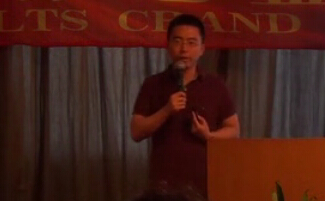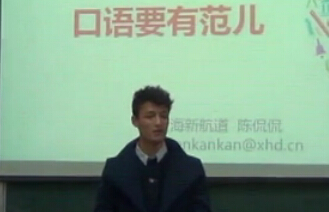英语倒装句用法总结(二)
2017-11-28 10:43 供稿单位: 新航道
出国英语考试有哪些 雅思6.5是什么水平 雅思阅读评分标准 托福阅读评分标准 雅思和托福的区别
涉及only的倒装及考题分析
按英语习惯同,当“only+状语”位于句首时,其后句子要用部分倒装。如:
Only then did he realize that he was wrong. 到那时他才意识到他错了。
Only in this way are you able to do it well. 你只有用这种方法才能把它做好。
Only in this way can our honour be saved. 只有这样,才能保住我们的荣誉。
Only then did I understand what she meant. 只有到那时我才明白她的意思。
Only after her death was I able to appreciate her. 只有到她死后我才认识到她的价值。
Only when he returned home did he realize what had happened. 当他回到家里时,才知道出了什么事。
Only in this way can we learn English. 只有这样才能学会英语。
The pilot reassured the passengers. Only then did I realize how dangerous the situation had been. 飞机驾驶员要乘客们放心,这时我才明白刚才的情况有多危险。
Only by shouting was he able to make himself heard. 他只有叫喊才能让别人听到他。
Only when we landed did we see how badly the plane had been damaged. 我们只是在着陆之后才看到飞机损坏的严重程度。
Only on one point do I agree with you. 只有一点,我同意你的说法。
【典型考题】(答案分别为DC)
1. Only then _________ how much damage had been caused.
A. she realized
B. she had realized
C. had she realized
D. did she realize
2. Only after my friend came _________.
A. did the computer repaired
B. be repaired the computer
C. was the computer repaired
D. the computer was repaired
特别说明:
有时命题者不是利用位于句首的“only+状语”来考查倒装,而是倒过来,利用给定的倒装结构来考查对only的选择。如下面一题(答案选A):
_________ by keeping down costs will Power Data hold its advantage over other companies.
A. Only B. Just C. Still D. Yet
涉及副词so的两类常考倒装
这类倒装主要见于以下两种情形:
1.当副词so后接形容词或副词位于句首时,其后要用部分倒装。如:
So cold was the weather that we had to stay at home. 天气太冷,我们只好呆在家里。
So fast does light travel that we can hardly imagine its speed. 光速很快,我们几乎没法想象它的速度。
So sudden was the attack that we had no time to escape. 袭击来得非常突然,我们来不及逃跑。
2. 当要表示前面提出的某一肯定的情况也同样适合于后者,通常就要用“So+助动词+主语”这种倒装结构。如:
You are young and so am I. 你年轻,我也年轻。
She likes music and so do I. 她喜欢音乐,我也喜欢。
If he can do it, so can I. 要是他能做此事,我也能。
【典型考题】(答案分别为BBA)
1. So difficult _________ it to work out the problem that I decided to ask Tom for advice.
A. I did find B. did I find C. I have found D. have I found
2. _________ about wild plants that they decided to make a trip to Madagascar for further research.
A. so curious the couple was B. So curious were the couple
C. How curious the couple were D. The couple was such curious
3. —It’s burning hot today, isn’t it?—Yes. _________ yesterday.
A. So was it B. So it was C. So it is D. So is it
特别说明:
(1) 若前面提出某一否定的情况,要表示后者也属于同样的否定情况,则应将其中的so改为neither或nor。如:
You aren’t young and neither am I. 你不年轻,我也不年轻。
She hasn’t read it and nor have I. 她没有读它,我也没有读。
请看考题(答案选D):
Mary never does any reading in the evening, _________.
A. so does John B. John does too
C. John doesn’t too D. nor does John
(2) 注意“So+助动词+主语”与表示强调或同意的“So+主语+助动词”的区别。如:
“It was cold yesterday.” “So it was.” “昨天很冷。”“的确很冷。”
请看考题(答案分别为CD):
1.— Maggie had a wonderful time at the party. —_________, and so did I.
A. So she had B. So had she C. So she did D. So did she
2.—Father, you promised! —Well, _________. But it was you who didn’t keep your word first.
A. so was I B. so did I C. so I was D. so I did
倒装句中的主谓一致
在“副词here, there, now, then, up, down, in, out, away等、作状语或表语的介词短语或分词短语+谓语动词+主语”的倒装结构中,谓语动词的数由动词后面的主语决定。如:
On the wall hang two maps. 墙上挂着两张地图。
On the wall hangs a world of map. 墙上挂着一张世界地图。
Here is your coat. 这是你的外套。
Here are your running-shoes. 这是你的跑鞋。
Such is the result. 结果就是这样。
Such are the results. 这就是结果。
副词后的倒装
here 和 there 之后以及诸如 back, down, off, up 等一类的副词小品词之后,名词主语一般置于谓语之后。这类副词常与诸如 come 和 go 等转移动词一起连用。如:
Here comes a taxi! There goes the last train! 有辆出租车来了! 一班火车开走了! (注意这里不可用进行时)
Down came the rain and up went the umbrellas. 下雨了,伞都撑了起来。
当我们给人东西或确定位置时,这种倒装常用在be之后(主语往往是复数)。如:
Here’s a cup of tea for you. 给你一杯茶。(给东西)
Here’s your letters. 这儿有你的信。(给与或指明)
There’s (重读) Johnny smith. 约翰尼·史密斯在那儿。(确定位置)
主语如是代词则不倒装。如:
Here it comes. 它来了。
There she goes. 她走了。
Up it went. 它上去了。
Here you are. 给你。
There she is. 她在那儿。
地点状语后的倒装
地点状语后面如有表示位置的动词 (如lie, live, sit, stand) 或转移的动词 (如come, go, rise),用作主语的名词可以放在动词之后。这种情形主要出现在描写文中。如:
At the top of the hill stood the tiny chapel. 那座小教堂矗立在山顶上。
In the fields of poppies lay the dying soldiers. 罂粟地里躺着奄奄一息的士兵们。
别的动词如属被动语态也可以倒装。
In the distance could be seen the purple mountains. 远处可以见到紫色的山。
主语如是代词则不能倒装:
At the top of the hill it stood out against the sky. 它背衬青天矗立在山顶上。
否定副词之后的倒装
否定或近似否定副词(往往是时间或频度副词,如never, rarely, seldom),或是具有否定作用的副词,如 little, on no account 等。如:
Never / Seldom has there been so much protest against the Bomb. 这么强烈的反对原子弹的抗议活动从未 / 很少 / 有过。
Little does he realize how important this meeting is. 他对这个会议的重要性不甚了了。
On no account must you accept any money if he offers it. 他如要给你钱,你可绝不能接受。
当这种副词不在句首时,当然应该用正常词序:
There has never / seldom been so much protest against the Bomb. 从未 / 很少发生过这么强烈的反对原子弹的抗议活动。
He little realizes how important this meeting is. 他不甚明白这个会议的重要性。
另外,有些含有否定意义的介词短语置于句首时,其后也要用倒装。如:
In no case should you give up. 你绝不能放弃。
On no condition should we tell her about it. 我们绝不能把此事告诉她。
On no accounts must this switch be touched.这个开关是绝 不能触摸的。
In [Under] no circumstances will I lend money to him.无论如何我也不会再借钱给他了。
Under no circumstances should you lend him any money. 你无论如何都不该把钱借给他。
No way will I go on working for that man. 我不再给那个人工作了
涉及not only…but also…的部分倒装
not only…but also…前后连接两个句子时,not only后的句子要用部分倒装,但but also后的分句不用倒装。如:
Not only did he come, but he saw her. 他不仅来了,而且还见到了她。
Not only does she speak Spanish, (but) she also knows how to type. 她不但会说西班牙语,还会打字呢。
Not only is he a teacher, but he is also a poet. 他不仅是一位教师,而且是一位诗人。
Not only did he speak more correctly, but he spoke more easily. 不仅他讲得更正确,也讲得更不费劲了。
Not only did they present a musical performance, but they also gave a brief introduction to the history of Western brass instruments. 他们不但做了音乐表演,而且简短地介绍了西方铜管乐器的历史。
类似So / Neither do I的部分倒装
so / neither / nor表示前面所说的情况也适合于后者时,其句型是:so / neither / nor+特殊词+主语。使句此句型需注意以下几点:
①内容是肯定时,用so,内容是否定时,用neither或nor;
②“特殊词”与前句中的情态动词、助动词或be相同,或根据前句的时态,用do, does, did;
③“特殊词”的人称和数与其后的主语一致;
④“特殊词”本身没有否定形式。如:
You are young and so am I. 你年轻,我也年轻。
She likes music and so do I. 她喜欢音乐,我也喜欢。
If he can do it, so can I. 要是他能做此事,我也能。
You aren’t young and neither am I. 你不年轻,我也不年轻。
She hasn’t read it and nor have I. 她没有读它,我也没有读。
涉及so…that的部分倒装
在so... that…结构中,若将so+adj. / adv. 置于句首,则其后的主句要用部分倒装。如:
So cold was the weather that we had to stay at home. 天气太冷,我们只好呆在家里。
So much did they eat that they could not move for the next hour. 他们吃得太多了,一个小时都动弹不得。
So loudly did he speak that even people in the next room could hear him. 他讲话声音那么大,隔壁屋里的人都听得见。
So fast does light travel that we can hardly imagine its speed. 光速很快,我们几乎没法像它的速度。
So sudden was the attack that we had no time to escape. 袭击来得非常突然,我们来不及逃跑。
类似地,当such…that…结构的such…置于句首时,such后的句子也要使用部分倒装。如:
Such a nice man did he seem that we all believe him. 他像个很和蔼的人,所以我们都喜欢他。
表语或状语置于句首时的完全倒装
有时为了强调或者为了使句子平衡或者为了使上下文连接得更加紧密,就将表语和地点状语(多为介词短语)置于句首,谓语动词也常置于主语前,构成完全倒装。如:
By the door stood an armed guard. 门口站着一名手持武器的士兵。
At the next table was a pretty girl waiting for someone. 隔壁桌上坐着一个等人的漂亮姑娘。
Among these people was his friend Jim. 他的朋友吉姆就在这些人当中。
By the window sat a young man with a magazine in his hand. 窗户边坐着一个年轻人,手里拿着一本杂志。
At the front of the book is a table of contents, giving details of what is in the book. 书的前部有目录,详列了书中的内容
as引导让步状语从句时的倒装
as作“虽然”解,引导让步状语从句时,必须将表语、状语或动词原形提到as前面。此时应注意几点:一是若提前的表语是没有形容词修饰的单数可数名词,要省略不定冠词;二是若提前的是动词原形(多为不及物动词),与之连用的通常是may, might, will, would等,且这些词都要保留在原来的位置上(主语后);三是though有时也可像as这样使作倒装。如:
Tired as I was, I tried to help them. 虽然我很累,我还是努力帮助他们。
Try as he would, he couldn’t open the door. 他试过多次了, 却仍打不开那门。
Search as they would, they would find nobody in the house. 无论怎样搜查,他们在房子里仍然没有找到一个人。
Hard as (though) they tried, they couldn’t make her change her mind. 尽管他们做了很大努力,却没法让她改变主意。
Boy as he was, he behaved like a girl. 他虽是个男孩,但举止却像个女孩。
非谓语动词置于句首的倒装
有时为了强调,可将谓语部分的现在分词、过去分词或不定式置于句首,从而构成倒装。如:
Buried in the sands was an ancient village. 一个古老的村庄被埋在这沙土之中。
Standing beside the table was his wife. 站在桌旁的是他的妻子。
To be carefully considered are the following questions. 下列问题要仔细考虑
- 上一篇:这些“说话技巧”可以助你学好雅思
- 下一篇:20种常见英文修辞手法

- 新航道,英语成功之道。时间获取新航道英语学习资料和新鲜资讯,请在微信公众账号中搜索「新航道英语」或者「xhdenglish」,或用手机扫描左方二维码,即可获得新航道每日精华内容推送和英语学习经验分享,并参与新航道举办的各项活动。
精彩专题
更多视频荟萃
更多
-
新航道姚骏鹏-雅思阅读高分攻略
时长:03-06

-
新航道陈侃侃-雅思口语要有范儿
时长:03-06

-
【3分钟学雅思】王大锤告诉你为啥药不能停
时长:01-12

-
【3分钟学雅思】全世界个感官餐厅
时长:01-12
热门文章
更多
-
8月31日雅思广州考机考初体验
选择机考模式的考生将通过机考模式参加听...








